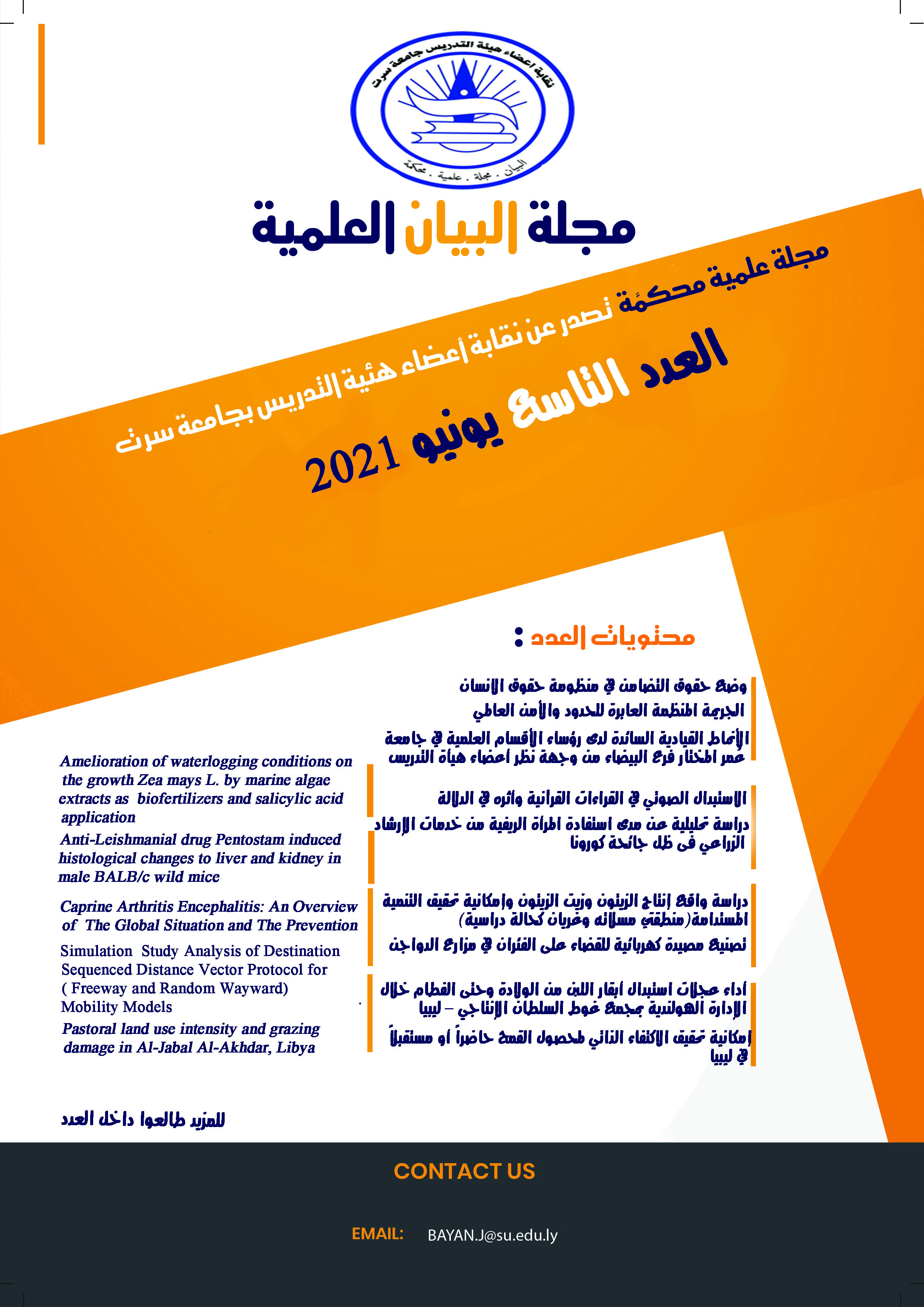Antibacterial Activity and Phytochemical Investigation of Matricaria Chamomilla Plantand UV Spectra Analysisof Chaticenein Methanolic Extract
Keywords:
Antibacterial,, MatricariaChamomilla,, Phytochemical analysis,, Chaticene.Abstract
-
The present study describes the phytochemical profile and antibacterial activity of flowers ofMatricariachamomilla profusely prescribed in traditional medicine. The phytochemical investigations revealed many principles of bioactive properties in animal and human sterols, triterpens, flavonoids, saponins, tannins and alkaloids. The antibacterial activity was examined using agar well-diffusion method, using two extracts; distillated water andmethanolic against two gram positives (Staphylococcus aureus ATCC 25923 and Bacillus subtilis NCTC 8236) and two gram negatives (Escherichia coli ATCC 25922 and Pseudomonas aeruginosa ATCC 27853).The results showed that the methanolic extract have significant antibacterial activity. Alsothe UV spectra identify of Chaticene compound in methanolic extract of Chamomile.The current study supports theemployment of plant in folk medicine and recommends further microbiological and pharmacological studies as a promising sources for new antibacterial agents.
References
References:-
Anand A. Zanwar, Subhash L. Bodhanka .(2014)in Polyphenols in Human Health and Disease.
Didry, N., Dubreuil, L., Trotin, F., Pinkas, M. (1998): Antimicrobial activity of the aerial parts of DroserapellataSmith on oral bacteria. J. Ethnopharmacol. 60: 91-96.
Farnsworth, N.R. (1993): Biological approaches to the screening and evaluation of natural products. In: Rasoanaivo P, Ratsimamanga-Urverg S (Eds) Biological Evaluation of Plants with Reference to the Malagasy Flora, Madagascar, pp. 35-43.
Fatouma, M., Abdoul-Latif, N.M., Prosper, E.P., Adwa, A.A., Samatar, O.D., Louis-Clément, O., et al.( 2011): Antimicrobial and antioxidant activities of essential oil and methanol extract of Matricariachamomilla L. from Djibouti. J. Med. Plants Res. 5(9): 1512-1517.
Gordon M.C ;David, J. N. ( 2001) : Natural product drug discovery in the next millennium, Pharmaceutical Biology,vol.39,pp.8– 17.
Harborne,J.B. (1986 ) : Nature, distribution and function of plant flavonoids. Progress in Clinical and Biological Research,vol.213, pp.15–24.
Jager, A.K., Hutchings, A., van Staden, J. (1996): Screening of Zulu medicinal plants for prostaglandinsynthesis inhibitors. J. Ethnopharmacol. 52: 95-100.
Kassi, E., Papoutsi, Z., Fokialakis, N., Messari, I., Mitakou, S., Moutsatsou, P. (2004).: Greek plant extracts exhibit selective estrogen receptor modulator (SERM)-like properties. J. Agricult.Food Chem. 52: 6956-6961.
Kato, A., Minoshima, Y., Yamamoto, J., Adachi, I., Watson, A.A., Nash, R. J. (2008): Protective effects of dietary chamomile tea on diabetic complications. J. Agricult. Food Chem. 56: 8206-8211.
Kroll, U.,Cordes, C. (2006): Pharmaceutical prerequisites for a multi-target therapy. Phytomedicine 13(5): 12-19
Lemberkovics, E., Kery, A., Marczal, G., Simandi, B., Szoke, E. ( 1998): Phytochemical evaluation of essential oils, medicinal plants and their preparations. ActaPharma Hung. 68(3): 109-141.
Martins, M.D., Marques, M.M., Bussadori, S.K., Martins, M.A., Pavesi, V.C., Mesquita-Ferrari, R.A., Fernandes, K.P. ( 2009): Comparative analysis between Chamomillarecutita and corticosteroids on wound healing : An in vitro and in vivo study. Phytother. Res. 23(2): 274-278.
Miles, A.A., Misra, S.S. ( 1938): The estimation of the bactericidal power of the blood. J. Hygiene, 38: 732-749.
Nissen, H.P., Biltz, H., Kreysel, H.W. (1988): Profilometry, a method for the assessment of the therapeutic effectiveness of Kamillosan ointment. Z Hautkr. 63(3):184-190.
Romero, C.D., Chopin, S.F., Buck, G., Martinez, E., Garcia, M., Bixby, L. (2005): Antibacterial properties of common herbal remedies of the southwest. J. Ethnopharmacol. 99: 253-257.
Saller, R., Beschorner, M., Hellenbrecht, D., Bühring, M. (1990): Dose-dependency of symptomatic relief of complaints by chamomile steam inhalation in patients with common cold. Eur. J. Pharmacol. 183: 728-729.
Shale, T.L., Strik, W.A., van Staden, J. (1999): Screening of plants used by southern African traditional healers in the treatment of dysmenorrhoea for prostaglandin-synthesis inhibitors and uterine relaxing activity. J. Ethnopharmacol. 64: 9-14.
Springob.K; Saito,K.( 2002) : Metabolic engineering of plant secondary metabolism: promising approach to the production of pharmaceuticals.”Science and Culture,vol.68,pp.76–85.
Srinivasan, D., Nathan, S., Suresh, T., Perumalsamy, O. (2001):Antimicrobial activity of certain Indian medicinal plants used in folkloric medicine. J. Ethnopharmacol. 74:217-220.
Sukhadev, S.H., Suman, P.S.K., Gennaro, L., Dev, D.R. (2008): An overview of extraction techniques for medicinal and aromatic plants. In: Sukhdev SH et al. (Eds). Extraction technologies for medicinal and aromatic plants. International Center for Science and High Technology. Trieste, Italy.
Taylor, J.L.S., Rabe, T., McGraw, L.J., Jager, A.K., van Staden, J. (2001):Towards the scientific validation of traditional medicinal plants. Plant Growth Regul. 34: 23-37.
Way, T.D., Kao, M.C., Lin, J.K. (2004): Apigenin induces apoptosis through proteasomal degradation of HER2/neu in HER2/neu-over-expressing breast cancer cells via the phosphatidylinositol-3'-kinase/Akt-dependent pathway. J. Biol. Chem. 279: 4479-4489.
Wink, M .(1999) : Introduction: biochemistry, role and biotechnology of secondary products,” inBiochemistry of Secondary Product Metabolism, M. Wink, Ed., pp. 1–16, CRC Press, Boca Ratom, Fla, USA.













